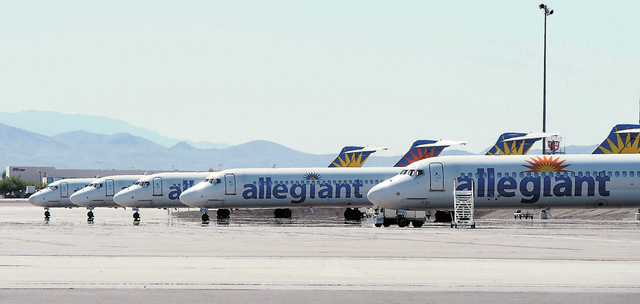Allegiant’s reliance on MD-80s is costing it big bucks
When other airlines retire jets such as the MD-80 by parking them in the desert, they generally justify the move as lowering operating costs and clearing the way for newer, passenger-pleasing models.
Management at Allegiant Air, in keeping with its business DNA, has always gone in the opposite direction. What others labeled obsolete fit the company’s profile for opportunity, so management built a fleet of MD-80s that they bought used at low-low prices.
As one of the pillars of Allegiant, a unit of Las Vegas-based Allegiant Travel Co., the fleet strategy has helped produce consistent and industry-leading profits. But part of the downside cropped up Sept. 20, as the airline had to ground about three-fourths of its available MD-80s because of a flaw in maintenance procedures.
To be sure, the problem did not stem from the plane itself but the failure by the Allegiant maintenance staff to rewrite its manuals in 2007, when the manufacturer of the emergency slides required annual overhauls instead of once every three years.
Nor are operational problems confined to older aircraft; witness the teething troubles of the new Boeing 787 and Airbus A380.
But, much like people, airliners need more care and repair as they age. As far as what flies today, it is hard to get much more elderly than the MD-80, a descendent of the DC-9 that first went into service in 1965 and went out of production nearly 15 years ago. They have been around long enough that some in the industry refer to them as DC-9osaurs.
As a result, the average age of an Allegiant plane is about 23 years, old enough that Allegiant has occasionally bought MD-80s just for parts. By contrast, Southwest planes are about 10 1/2 years old.
Allegiant management looks at this through a different prism, however: An MD-80 is rated to last about 100,000 flights, called cycles, spokesman Brian Davis said. Many of its planes have flown only about 30,000 cycles and do not spend nearly as much time in the air as do planes at other carriers.
The rationale for Allegiant choosing age over youth has always been simple, if maverick. The purchase price of MD-80s is so low, particularly because the narrow body does not make them attractive to cargo carriers, that it more than financially justifies the extra time with mechanics.
The MD-80s also have a reputation as gas guzzlers. But again, acquiring them cheap and with cash means that Allegiant can afford to reduce the schedules and simply park the planes during those periods when fuel prices spike faster than their ability to raise fares in response. In the minds of Allegiant management, this easily makes more sense than undertaking the elaborate and expensive fuel hedging strategies that other airlines have tried, or borrowing to purchase more expensive planes that must stay in the air no matter what in order to cover monthly finance charges.
But there has been a price to pay. A couple of years ago, Allegiant embarked on a program to overhaul all of the engines after breakdowns started to become a major issue. Many of Allegiant’s destinations are in desert locales well above sea level — known as flying hot and high — that put an extra strain on already aging hardware. This depressed profits for several quarters, but it still made sense financially to keep MD-80s as the backbone of the fleet.
But the recent debacle of having to ground so many at once, scrambling the travel plans for thousands of passengers whose flights ran hours late or were even postponed to the next day, originated on Sept. 16. The smoke alarm went off in an MD-80 on a taxiway at McCarran International Airport, prompting the emergency evacuation of the passengers. Of the four emergency slides on the plane, one malfunctioned. This drew a routine Federal Aviation Administration followup investigation that discovered the flaw in Allegiant’s maintenance procedures.
Wall Street analysts are already guessing at how much this will reduce Allegiant’s third-quarter profits, from having to pay for hotel rooms for passengers stranded overnight to chartering planes to fill out the schedule. Allegiant has not put out any estimates.
How much longer incidents such as these will hang over Allegiant is hard to guess. The airline has started to retire some of its MD-80s and has found prices for secondhand Airbus A319s attractive enough to take on the role of replacements. Still, of the 61 planes currently in the fleet, 52 are MD-80s, so the transition will take years.














